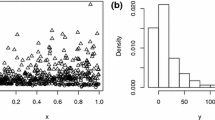Abstract
Mixture regression models have increasingly received attention from both marketing theory and practice, but the question of selecting the correct number of segments is still without a satisfactory answer. Various authors have considered this problem, but as most of available studies appeared in statistics literature, they aim to exemplify the effectiveness of new proposed measures, instead of revealing the performance of measures commonly available in statistical packages. The study investigates how well commonly used information criteria perform in mixture regression of normal data, with alternating sample sizes. In order to account for different levels of heterogeneity, this factor was analyzed for different mixture proportions. As existing studies only evaluate the criteria’s relative performance, the resulting success rates were compared with an outside criterion, so called chance models. The findings prove helpful for specific constellations.
Access this chapter
Tax calculation will be finalised at checkout
Purchases are for personal use only
Preview
Unable to display preview. Download preview PDF.
Similar content being viewed by others
References
AITKIN, M., RUBIN, D.B. (1985): Estimation and Hypothesis Testing in Finite Mixture Mod-els. Journal of the Royal Statistical Society, Series B (Methodological), 47 (1), 67-75.
AKAIKE, H. (1973): Information Theory and an Extension of the Maximum Likelihood Prin-ciple. In B. N. Petrov; F. Csaki (Eds.), Second International Symposium on Information Theory (267-281). Budapest: Springer.
ANDREWS, R., ANSARI, A., CURRIM, I. (2002): Hierarchical Bayes Versus Finite Mixture Conjoint Analysis Models: A Comparison of Fit, Prediction and Pathworth Recovery. Journal of Marketing Research, 39 (1), 87-98.
ANDREWS, R., CURRIM, I. (2003a): A Comparison of Segment Retention Criteria for Finite Mixture Logit Models. Journal of Marketing Research, 40 (3), 235-243.
ANDREWS, R., CURRIM, I. (2003b): Retention of Latent Segments in Regression-based Marketing Models. International Journal of Research in Marketing, 20 (4), 315-321.
BOZDOGAN, H. (1987): Model Selection and Akaike’s Information Criterion (AIC): The General Theory and its Analytical Extensions. Psychometrika, 52 (3), 346-370.
BOZDOGAN, H. (1994): Mixture-model Cluster Analysis using Model Selection Criteria and a new Information Measure of Complexity. Proceedings of the First US/Japan Confer-ence on Frontiers of Statistical Modelling: An Informational Approach, Vol. 2 (69-113). Boston: Kluwer Academic Publishing.
DEMPSTER, A. P., LAIRD, N. M., RUBIN, D. B. (1977): Maximum Likelihood from In-complete Data via the EM-Algorithm. Journal of the Royal Statistical Society, Series B (Methodological), 39 (1), 1-39.
DESARBO, W. S., DEGERATU, A., WEDEL, M., SAXTON, M. (2001): The Spatial Repre-sentation of Market Information. Marketing Science, 20 (4), 426-441.
GRÜN, B., LEISCH, F. (2006): Fitting Mixtures of Generalized Linear Regressions in R. Computational Statistics and Data Analysis, in press.
HAHN, C., JOHNSON, M. D., HERRMANN, A., HUBER, F. (2002): Capturing Customer Heterogeneity using a Finite Mixture PLS Approach. Schmalenbach Business Review, 54 (3),243-269.
HAWKINS, D. S., ALLEN, D. M., STROMBERG, A. J. (2001): Determining the Number of Components in Mixtures of Linear Models. Computational Statistics & Data Analysis, 38 (1),15-48.
JEDIDI, K., JAGPAL, H. S., DESARBO, W. S. (1979): Finite-Mixture Structural Equation Models for Response-Based Segmentation and Unobserved Heterogeneity. Marketing Science, 16 (1), 39-59.
LEISCH, F. (2004): FlexMix: A General Framework for Finite Mixture Models and Latent Class Regresion in R. Journal of Statistical Software, 11 (8), 1-18.
MANTRALA, M. K., SEETHARAMAN, P. B., KAUL, R., GOPALAKRISHNA, S., STAM, A. (2006): Optimal Pricing Strategies for an Automotive Aftermarket Retailer. Journal of Marketing Research, 43 (4), 588-604.
MCLACHLAN, G. J., PEEL, D. (2000): Finite Mixture Models, New York: Wiley.
MORRISON, D. G. (1969): On the Interpretation of Discriminant Analysis, Journal of Mar-keting Research, Vol. 6, 156-163.
OLIVEIRA-BROCHADO, A., MARTINS, F. V. (2006): Examining the Segment Re-tention Problem for the "Group Satellite" Case. FEP Working Papers, 220. www.fep.up.pt/investigacao/workingpapers/06.07.04_WP220_brochadomartins.pdf
RISSANEN, J. (1978): Modelling by Shortest Data Description. Automatica, 14, 465-471.
SARSTEDT, M. (2006): Sample- and Segment-size specific Model Selection in Mix-ture Regression Analysis. Münchener Wirtschaftswissenschaftliche Beiträge, 08-2006. Available electronically from http://epub.ub.uni-muenchen.de/archive/00001252/01/2006_08_LMU_sarstedt.pdf
SCHWARZ, G. (1978): Estimating the Dimensions of a Model. The Annals of Statistics, 6 (2), 461-464.
WEDEL, M., KAMAKURA, W. A. (1999): Market Segmentation. Conceptual and Method-ological Foundations (2nd ed.), Boston, Dordrecht & London: Kluwer.
Author information
Authors and Affiliations
Editor information
Editors and Affiliations
Rights and permissions
Copyright information
© 2008 Springer-Verlag Berlin Heidelberg
About this paper
Cite this paper
Sarstedt, M., Schwaiger, M. (2008). Model Selection in Mixture Regression Analysis–A Monte Carlo Simulation Study. In: Preisach, C., Burkhardt, H., Schmidt-Thieme, L., Decker, R. (eds) Data Analysis, Machine Learning and Applications. Studies in Classification, Data Analysis, and Knowledge Organization. Springer, Berlin, Heidelberg. https://doi.org/10.1007/978-3-540-78246-9_8
Download citation
DOI: https://doi.org/10.1007/978-3-540-78246-9_8
Publisher Name: Springer, Berlin, Heidelberg
Print ISBN: 978-3-540-78239-1
Online ISBN: 978-3-540-78246-9
eBook Packages: Mathematics and StatisticsMathematics and Statistics (R0)





